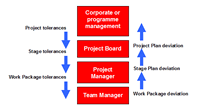PRINCE2 - Controls part 3
of the Cabinet Office under delegated authority from the Controller of HMSO.
Tolerance
The project must stay in line with the expectations identified in the Project Initiation Document and the Stage Plan.
Tolerance is the permitted deviation from a plan without the need to raise it as an issue with the next level of authority.
Every plan will have deviations, some small and some large. These will occur throughout the plan.
The Project Manager and Team Managers want to be able to run the project by ‘exception’. However, there will be times when any deviations are so great they will need the intervention of the Project Board or Project Manager (for Team Managers) to resolve any issues.
The limit of these deviations before intervention is required will be the tolerance.
There will be a hierarchy of tolerances levels, starting at the top.
Corporate or programme management will identify initial tolerance levels in the Project Mandate for the Project Board which will be incorporated into the Project Brief.
These may be ascertained by the Executive during project start up.
In turn the Project Board will agree tolerances with the Project Manager for the project stages.
The Project Manager may then agree Work Package tolerances with the Team Managers.
Should any tolerance levels be exceeded they should be reported to the next level of management upwards.
For the example of a Work Package the Project Manager may set new tolerance levels.
However, the Project Manager should only do this if the affect on the stage will not exceed its tolerance levels.
For this reason any modification of tolerance levels should be considered very carefully.
If this will not be the case the Project Manager must refer the issue to the Project Board.
In turn the Project Board may choose to set new tolerances or may have to refer the issue to corporate or programme management if overall project tolerances will be exceeded.
Hence there is a continuing cascade effect.
This is seen in the diagram.
Two key elements of tolerance that interest people are:
- Time
- Cost
The setting of tolerances is part of the process Planning (PL).
In general, it may be more useful to provide real tolerance values in terms of dollars / pounds or days rather than +/- 10%.
There is no reason that the upper and lower should be the same. It may be more realistic to use +10% / -20%.
A simple diagram can be seen in the file ‘cost-time tolerance graph.doc’) in the product package.
It shows what may happen if a plan deviates from the original.
If it is judged to be going outside of the tolerances set then a specific procedure will be invoked, see Exception Report and Exception Plan.
Otherwise it is ‘management by exception’.
The reason for any apparent deviation requires careful consideration.
It is possible that early spending may cause an apparent deviation from the plan but will, in fact, remain within tolerance levels by the end of the project.
Scope
This can be used if tolerances for time and money are unavailable.
It could be that time and cost tolerances could be met by reducing the project scope.
That is, the quality may be reduced or what the customer is expecting may not all be there.
Some aspects of the project are ‘essential’ and others are ‘desirable’.
The difference is the tolerance.
You will need to define these before considering ‘de-scoping’ the project for any reason.
Risk
This can be known as ‘risk appetite’, that is, just how much risk is the Project Board prepared to take?
This may well depend on the area and the environment at the time.
A company in financial difficulties will have little risk tolerance in the financial area but may have a high risk tolerance in the area of product quality.
Whilst risk tolerance is usually taken or the project as a whole it can be used at other points in the project as necessary.
Benefit
These appear in the Business Case. Boundaries can be set on either side of a benefit.
Provided the forecast benefit falls within these and it will contribute to the Business Case and will be acceptable.
Quality
This may be a last resort to accept a reduced quality for the product.
This will be accepting an Off-Specification via a concession.
This may arise when a products colour range is limited to one only
That is some features may be limited.
Contingency tolerance and change budget
Contingency is not tolerance. Contingency id the provision of time and funds in a ‘contingency plan’ that will be put into action at the likelihood of a known risk occurring. In practice, this will be invoked once an agreed trigger occurs in an attempt to mitigate the impact of the known risk.
A change budget should be set up for this purpose at the start of the project.
If this is not done there will be a temptation to use up any tolerance that exists.
Without a change budget the Project Manager would have to return to the Project Board constantly trying to justify extra money for the changes.
This would be extremely time wasting.
Some tolerances may be tight.
If this is the case it may be necessary to widen other to compensate.
For example, in order to meet a tight time deadline it may be necessary to increase the expenditure on effort.
If all tolerances are extremely tight there may be a temptation to reduce quality unofficially.
Managing Successful Projects with PRINCE2 - 2005 edition
Managing successful Projects with PRINCE2 – 2009 edition
Directing Projects with PRINCE2.
plus:
The Complete Project Management package.
And much more besides - at a fantastic price.



